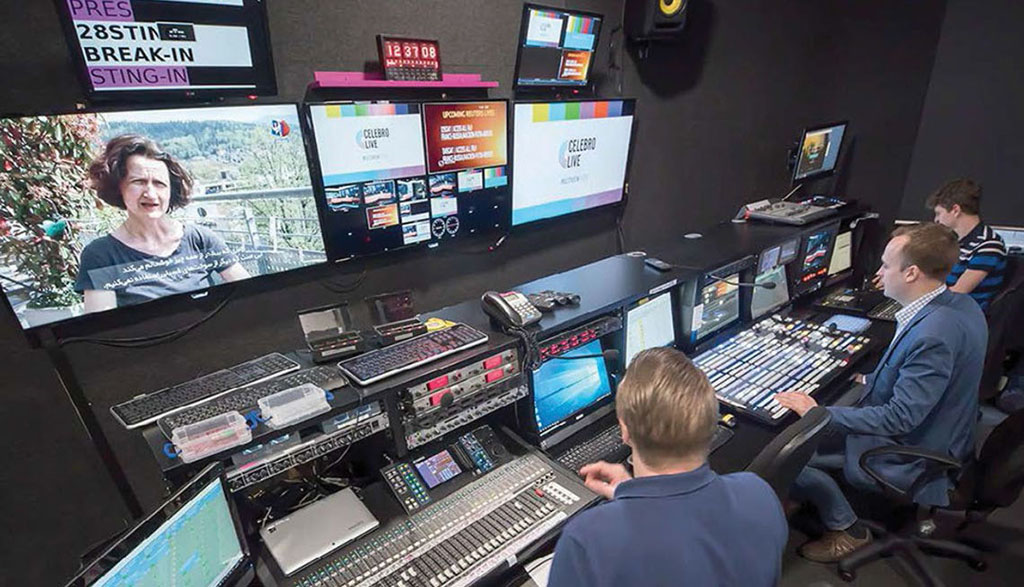Integrated Systems Break Down the Silos
OTTAWA—When the first NewTek TriCaster integrated video production system was introduced in 2005, its all-in-one functionality was limited to conventional SDI video signals, and whatever capability were “built into the box.”
In 2019, these walls have fallen down. Integrated production systems have embraced IP connectivity, and flexibility enhanced by network connections to exterior devices—whether physical or virtual. This can include remotely controlled PTZ (pan-tilt-zoom) cameras colocated with the integrated production switcher, or connected by IP anywhere in the world.
WHAT CUSTOMERS WANT

The vastly expanded capabilities of today’s integrated production systems are in sync with customer expectations, which have also grown exponentially since 2005. As a result, the “necessities” of current integrated production systems “include switching with a reasonable number of transition and effects options, clips and graphics search and playback, the ability to build playlists, record a primary mix along with multiple ISO input recording, Chroma-key support, lower thirds and logo keying, and streaming,” said Rush Beesley president of RUSHWORKS, a Dallas-based provider of live production gear.
At the same time, the expanding use of IP-delivered video by businesses, schools, churches, and other non-broadcast users means that “people coming to us these days are asking more about streaming than actual video production,” said Russell Whittaker, worldwide director of channel sales for Broadcast Pix in Boston. “That’s a bit of a seachange for us.”
Because these customers increasingly come from IT rather than TV backgrounds, they tend not to understand the benefit of SDI-based switching. “They live in a world of RJ-45 connectors,” said Whittaker. “For them, it must be good if it’s an IT technology.” This is why integrated production system manufacturers have moved so substantially to IP in their products, even though they retain SDI connections for broadcast users.
INDUSTRY TRENDS
The professional video industry's #1 source for news, trends and product and tech information. Sign up below.
The emphasis on IP connectivity, and the network-based possibilities it supports, is driving design in the development of integrated production systems.
“The biggest thing is flexibility,” said Will Waters, vice president of Customer Success for NewTek in Dallas. “You need to be able to have your production capability evolve in a way that is not locked into the original physical design of your switching equipment. Flexibility is the main thing we keep hearing about from customers.”
To support flexibility, Broadcast Pix, NewTek, and RUSHWORKS all support NewTek’s Network Device Interface (NDI) technology to allow their integrated systems to connect with NDI-enabled cameras, servers, and other video production equipment. By working in IP rather than baseband, “we’re moving forward into the world of virtualization, allowing us to access resources across the network through the integrated production system,” said Waters. “The limits are falling away.”

Beesley agrees. “I think the introduction of NDI has been very impactful, providing much more flexibility and freedom to introduce multiple sources with virtually no quality loss, and a significant reduction in expense and complexity,” he said. “NDI-capable cameras are certainly appropriate for integration into systems.”
The move into IP has also allowed integrated production systems to accept far more video sources than before; including those originating as data rather than signals. “The distinction between signals that had a BNC connection or a three-letter file extension is gone,” said Whittaker. “There is a lot more acceptance that a file is just as valid as a video signal.”
VENDOR ADVANCES
A number of new features have helped spur the market for integrated production systems in recent years.
For Broadcast Pix, the biggest development is data connectivity to the graphic creation systems within its BPSwitch line, according to Whittaker. “We’ve had that before, but we’ve extended the types of video signals,” he said. “Then there’s 3D motion graphics, which we launched in 2017 but started to deliver in force last year.” BPSwitch can now be run using a tablet or smartphone.
NewTek has developed a range of NDI-based tools for its TriCaster integrated production systems. They include NewTek Connect Pro (bridging conventional and IP-based workflows,), NewTek IsoCorder Pro (encoding video from up to 16 NDI sources in QuickTime format with 8-channel audio mixing), and NewTek Telestrator (adding live dynamic graphics to any NDI video source/still image).
Waters adds, “if you have a Windows PC and you can open up our application and connect to our integrated system, we can bring the user interface of our live production device anywhere that network can reach. Meanwhile, our NewTek Premium Access subscription service allows users to render real-time animation into live programming using Adobe After Effects and Photoshop— without using a conventional graphics pipeline.”
RUSHWORKS has added the ability to incorporate NDI and URL inputs and outputs into its products, and tweaked its PTZ cameras to provide a level of granularity and motion that removes the “robotic” look characteristic of the slow moves and zooms on most PTZ cameras, according to Beesley. RUSHWORKS’ VDESK integrated production system is the company’s flagship product in this area, with its portable version being branded as REMO.
COMING UP IN 2019
What can we expect from developers of integrated production system manufacturers in the year ahead?
At Broadcast Pix, “remote control is a big priority,” said Whittaker. “It appeals to people who have production facilities spread out between different locations. We also expect to increase the range of the number of IP inputs that our integrated systems can accept.”
Over at NewTek, “we’re heavily invested in the move to IT within our industry,” said Waters. “Without getting specific, we are looking to integrate into live production from control to advances in graphics and capturing live content for later re-use.”
Meanwhile, RUSHWORKS is completing a turnkey news production system designed to be operated by one person. “It’s an out-of-the-box solution that makes high-quality news production easily manageable and affordable for educational institutions, small TV stations, and the new world of internet TV Station entrepreneurs,” Beesley said.
Integrated production systems will push further into IP and enhanced flexibility in the years to come. In doing so, they will continue their march towards a level of sophistication and power that was once the sole preserve of traditional multiperson video production complexes.
James Careless is an award-winning journalist who has written for TV Technology since the 1990s. He has covered HDTV from the days of the six competing HDTV formats that led to the 1993 Grand Alliance, and onwards through ATSC 3.0 and OTT. He also writes for Radio World, along with other publications in aerospace, defense, public safety, streaming media, plus the amusement park industry for something different.

